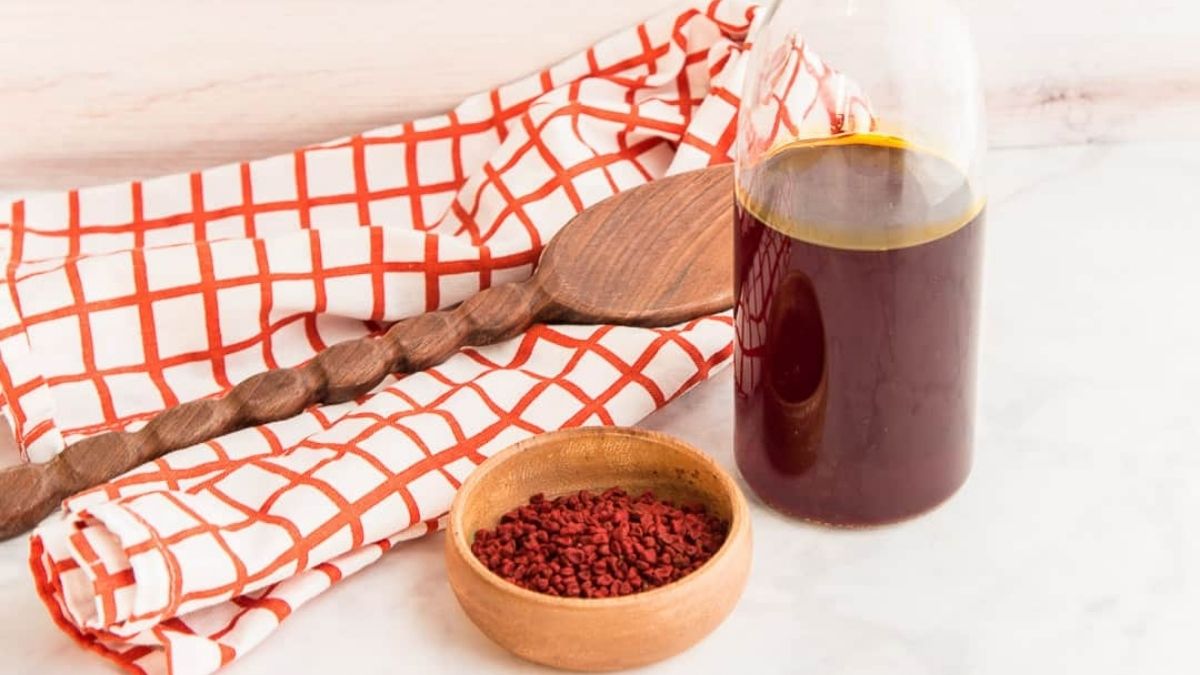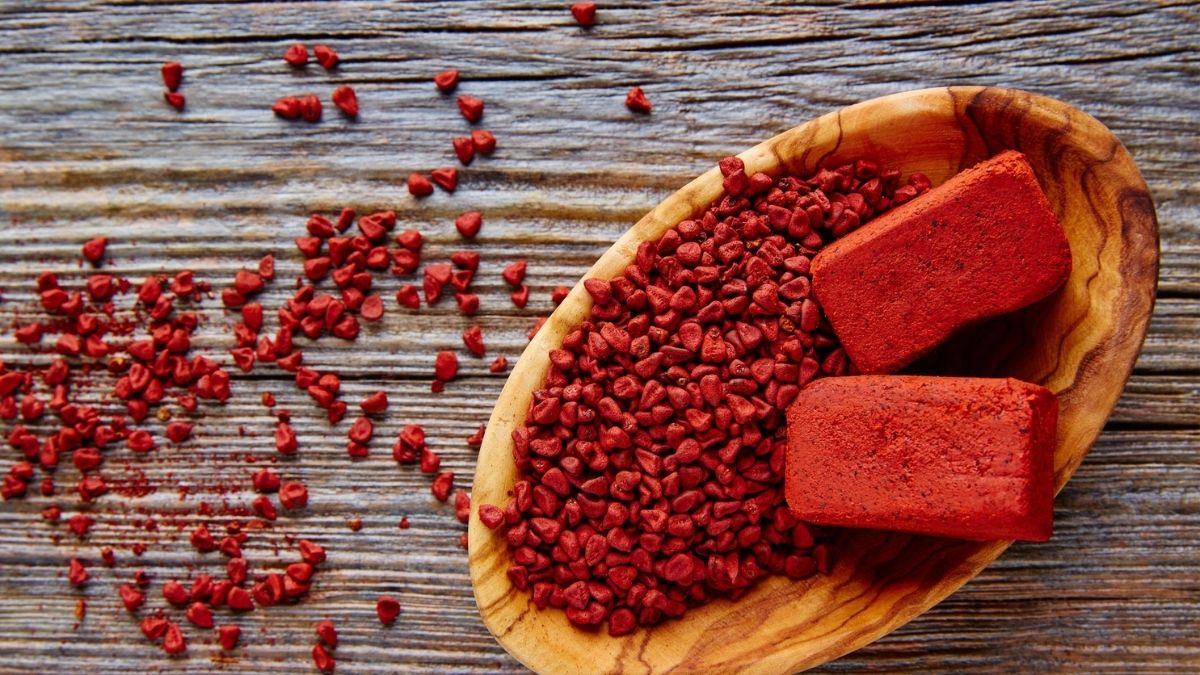The terms achiote and annatto are interchangeable. It has a slightly peppery flavour and is commonly used to give a dish a yellow hue. When investigating Mexican or Caribbean cuisine, you’ll frequently encounter this ingredient, whether as whole seeds or ground spice, achiote paste, or achiote oil. Achiote is also a colouring additive in foods worldwide, such as cheeses and packaged snacks.
Annatto is used to colour Mimolette, a semi-hard cow’s milk cheese from France, and yellow cheddar. Annatto is found in mustards, portions of margarine, and snacks like Goldfish and Cheeze-It crackers. But it’s not only for the sake of colour. Annatto has a distinct flavour that makes it suitable for use as a spice. When you inhale annatto, you’ll notice a nutty, flowery aroma. Annatto’s flavour is moderately sweet and spicy, with earthy, musky undertones.
What is Achiote?
The seeds of the evergreen Bixa Orellana shrub are used to make achiote, a spice and colouring agent. The pulp surrounding the seeds is formed into cakes after macerating in water and then processed into colours. The seeds are dried and used as a culinary spice, either whole or crushed. In the food industry, achiote imparts a yellow colour to chorizo, butter and margarine, cheese, and smoked salmon.
Achiote is a spice and food colouring agent derived from the seeds of the achiote tree, a South American, Central American, Mexican, and Caribbean species. The achiote tree seeds are located inside the fruit and can be ground into a powder, infused into oil, or made into a paste. Because of the naturally vibrant red-orange colour it gives, it has been employed as a culinary colouring agent in traditional cuisines in various parts of the world for generations.
Origins
Achiote is found in the Americas’ tropical regions, including the Caribbean and Mexico. The tiny tree was imported from the Americas to Southeast Asia by the Spanish in the 1600s, and it is now a common food component. India and West Africa also produce it.
In different parts of the world, this spice is known by several names:
- Mexico and the Aztec language of Nahuatl, as well as Spanish-speaking Caribbean regions, use achiote.
- Annato can be found on various Caribbean islands and parts of South America.
- In Trinidad and Tobago, Martinique, and Guadalupe, roucou is often used.
- The Philippines are the primary users of achuete.
How to Make Achiote Oil?
Annatto seeds and olive oil are used to make achiote oil. Many recipes, including yellow rice, use it to flavour and colour them. This dish is so straightforward that you’ll wonder why you’ve never tried it before. Achiote oil can be stored at room temperature for four to five days in a jar with a tight lid.
Ingredients
- 1 cup olive oil
- 2 1/2 tablespoons achiote seeds (or annatto seeds)
Steps to Make it
Tip
Avoid overheating the oil or seeds. The seeds will become black, and the oil will turn green if they are overheated. The oil is going to be ruined.
What does it Taste Like?
When used in small doses, achiote has no discernible flavour, mostly as a culinary colourant. It has an earthy, peppery flavour with bitterness when used in higher amounts to add flavour. The aroma of achiote seeds is slightly flowery or minty. Annatto is made from the seed of the achiote tree, which is native to the Americas. It’s frequently pounded into a paste and mixed into various dishes. Annatto isn’t particularly flavorful unless used in great quantities when it’s reported to bring earthy, flowery, and occasionally bitter qualities with a hint of pepper.
What are the Uses of Achiote?
Achiote is a commercial dye, food colorant, and culinary spice. Long before Europeans came, the Tano people of the Caribbean used achiote to flavor and color their food. It was also used as a fabric dye, body paint, sunscreen, and insect repellant. It’s also thought that the Aztecs used the seeds to improve the color of a chocolate drink. It was traditionally used for body painting, sunscreen, insect repellent, and treating ailments like heartburn, diarrhea, ulcers, and skin problems. It’s mostly utilized as a natural food coloring and flavor profile.
Cheeses, butter, margarine, custards, cakes, and baked goods contain this natural additive. Many cuisines use annatto seeds pounded into a paste or powder. As a result, it’s a key component in cochinita pibil, a slow-roasted pig dish popular in Mexico.
Its seeds can also be utilized to manufacture essential oils for aromatherapy, which may have antibacterial properties. Essential oils, on the other hand, are intended to be inhaled or applied to the skin, and they should not be swallowed because this is dangerous.
Where to Buy Achiote?
Ground, as seeds, as a paste, or infused in cooking oil or lard are all options for achiote. Look for it in your supermarket’s spice or international food section. Bottles, sacks, and vacuum-sealed bricks are examples of packaging. Achiote powder is frequently combined with other herbs, spices, and even cornstarch. If you have any food sensitivities, read the label carefully. Avoid drab or brown seeds, which are too old and have lost their flavour, and instead, buy vividly coloured red-orange seeds.
While you might get annatto in-ground, paste, or oil form in regular grocery stores, the best place to get it is at a store specializing in Central American, South American, Mexican, Caribbean, or Filipino goods. It’s also available in well-stocked spice shops.
Potential Health Benefits of Annatto
This natural food colouring has been associated with various potential health benefits.
Antioxidant Properties
Carotenoids, terpenoids, flavonoids, and tocotrienols are among the plant-based chemicals in annatto with antioxidant activities. Antioxidants are chemicals that can neutralize potentially hazardous molecules known as free radicals, which can cause cell damage if their levels increase too high. According to research, high free radical levels have been linked to chronic illnesses like cancer, cognitive disorders, heart disease, and diabetes.
Antimicrobial Properties
This food colouring may have antibacterial effects, according to research.
Annatto extracts were found to suppress the growth of a variety of bacteria in test tubes, including Staphylococcus aureus and Escherichia coli. Annatto destroyed many fungi in a test tube investigation, including Aspergillus niger, Neurospora scatophilia, and Rhizopus stolonifer. Furthermore, applying the colour to bread stopped fungus from growing, extending the bread’s shelf life.
Similarly, after 14 days in storage, pork patties treated with annatto powder exhibited less microbial development than untreated patties, according to one study. This study suggests that this food colouring could be useful in food preservation.
It May have Anticancer Properties
Annatto may have cancer-fighting properties, according to a preliminary study. Extracts of this food colouring, for example, have been found in test tubes to decrease cancer cell development and trigger cell death in human prostate, pancreas, liver, and skin cancer cells, among other cancer types. The carotenoids bixin and norbixin, and tocotrienols, a kind of vitamin E, have been related to the possible anticancer activities of annatto. While these findings are intriguing, further research into these effects in humans is required.
May Promote Eye Health
Carotenoids are abundant in annatto, which may aid eye health. It’s especially rich in the carotenoids bixin and norbixin, which are present in the seed’s outer layer and contribute to its brilliant yellow-to-orange hue.
Norbixin supplementation for three months reduced the accumulation of the molecule N-retinylidene-N-retinylethanolamine (A2E), which has been associated with age-related macular degeneration in animals (AMD). In elderly persons, AMD is the major cause of permanent blindness. However, further research on humans is required before annatto may be recommended for this use.
Other Potential Benefits
Annatto may offer other benefits, including:
- Heart health may be improved. Annatto is high in tocotrienols, vitamin E molecules that may protect against age-related heart problems.
- Inflammation may be reduced. Several test-tube investigations suggest that annatto chemicals may lower inflammatory indicators.
How to Store Achiote?
Ground Achiote should be kept in the same manner as other dry spices: In a dark, cool location, such as a pantry or spice closet. It will keep for up to three years if properly stored. Once opened, both the paste and the oil should be kept in sealed, refrigerated containers. The paste will last for three months and the oil for two weeks in the refrigerator.
Both seeds and ground achiote have a long shelf life. Achiote can last up to three years if stored properly. Please keep it in an airtight glass jar in a dark, out-of-the-way cupboard. When stored in a glass jar in the refrigerator, achiote oil or achieving will last a few months.
Safety and Side Effects
- Annatto appears to be safe for the majority of people.
- Despite its rarity, some people may develop an adverse reaction to it, particularly if they have sensitivities to plants in the Bixaceae family.
- Itching, swelling, low blood pressure, hives, and stomach ache are symptoms.
- Annatto may cause irritable bowel syndrome (IBS) symptoms in some people.
- Because there isn’t enough research on its safety in pregnant or breastfeeding women, it shouldn’t be consumed in doses higher than those present in foods.
- If you develop any unpleasant side effects after consuming this food colouring or goods containing it, stop using it immediately and consult your doctor.
Reduced inflammation, enhanced eye and heart health, and antioxidant, antibacterial, and anticancer qualities have all been associated with annatto, a natural food ingredient.
Conclusion
Annatto is an orange-red culinary colouring or condiment derived from the seeds of the achiote tree (Bixa Orellana), which grows in South and Central America’s tropical regions. Achiote, achiotillo, bija, urucum, and atsuete are some of the other names for it.It’s most typically used as a natural food colouring since it gives off a bright yellow to deep orange-red colour, akin to saffron and turmeric.
Carotenoids are pigments found in the seed’s outer layer, and many other fruits and vegetables, including carrots and tomatoes, give it its colour. Due to its slightly sweet and spicy flavour, annatto is also used as a condiment to improve the flavour of foods. Nutty, spicy, and flowery are the best words to describe its scent. It comes in powder, paste, liquid, and as an essential oil, among other forms.

